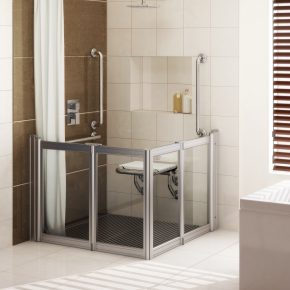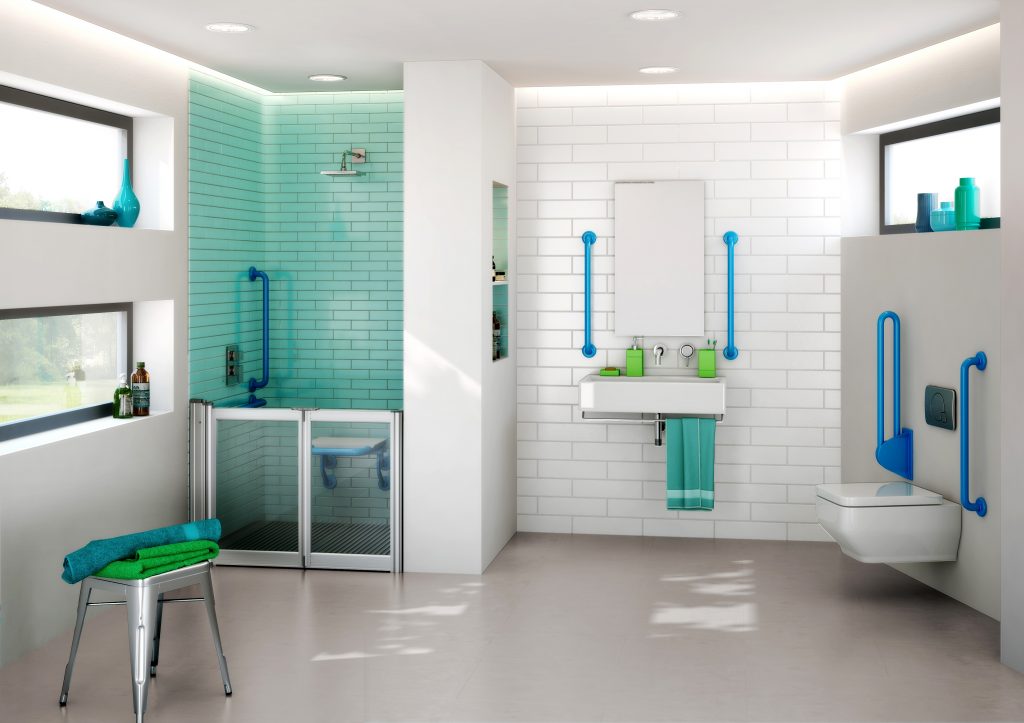
Future-proof bathrooms offer timeless style and timeless use – Neaco
This article from Neaco looks at future-proof bathrooms and how they can offer both timeless style and timeless use.
The concept of a future-proof home has broadened its appeal in the past decade. It used to be something that we only considered in our advancing years, but the evolution of design and a greater awareness of the long-term benefits have influenced a significant shift in mindset. Instead of treating the idea as an afterthought, many people are adopting a forward-thinking approach which ensures that a home never requires a costly and disruptive retrofit to accommodate changing circumstances such as declining mobility or the arrival of an elderly relative.
Today’s future-proof living is all about a layout that works at every stage of life, providing multigenerational use which suits a teenager and an octogenarian in equal measure. Getting the design right first time will save money on added installations further down the line.
Changing perceptions
As a space where safety in use is critical, the bathroom is subject to many of the most important design decisions in any future-proof home. It needs to be an environment that maximises accessibility and comfort whilst offering support for those that need it most.
In the past, there has been a common perception that facilities which aid mobility and independence have a clinical feel that is aesthetically incompatible with the finer details of contemporary bathroom design.
Many people have come to realise that the opposite is true: the best future-proof bathrooms demonstrate that user-friendly functionality and sophisticated styling can work in harmony.
Shower facilities are a perfect example. Traditional shower baths and shower trays are often cumbersome, with a high clearance that makes them more difficult to access for those of restricted mobility.
They are increasingly being replaced by less obstructive alternatives: wet rooms and level-access showers that provide frictionless floorspace throughout the bathroom.
Also known as walk-in showers, these options combine attractive minimalism with ease of access for all levels of mobility.
Wet rooms vs level-access showers
When comparing different types of walk-in shower, it is worth considering the potential drawbacks of wet rooms. The clue is in the name: a slight gradient in the floor directs the water into a small drainage point, which means the whole floor can become wet, especially with high-output showers. That can be problematic in terms of laborious cleaning and maintenance, hygiene issues and risk of slipping.
We advocate a less hazardous and more efficient option in the form of a level-access shower which has a built-in drainage catchment space below the floor level.
Rather than spreading across the bathroom, the water falls through a grille which sits flush to the rest of the floor, with no gradient required to effect drainage.
Neaco’s Neatdek 3 shower grille system remains unique to the market as the only facility that combines zero gradient with a seamless transition from the showering area to the rest of the bathroom – no steps, no ridges and no slopes.
It offers contemporary style without compromising safety. Neaco also manufactures a range of shower doors which complement our shower grilles and are also compatible with most wet room facilities.
The evolution of support fittings
To complement a level-access shower, well placed support fittings can enhance comfort and assist mobility to provide a facility suitable for a lifetime of use.
These could include grab rails and hinged shower seats or hinged support arms that fold back against the wall to save space when not in use.
In the past, these types of fixture have carried a negative association as features that make a bathroom look like a clinical or institutional environment rather than a homely, domestic setting.
Much of the blame for that perception can be attributed to a lack of imagination on the part of manufacturers – too many products have focused purely on the essential functionality without heed to the non-essential visual appeal. Design quality has often been rudimentary: worn, scratched plastics and rusting metal fixtures age the appearance of a bathroom.
The rare examples of high-end products have tended to come at significant extra cost, with a premium price on materials like chrome.
Thankfully, this rule of thumb no longer applies if you know where to look. Investments in product development, advanced manufacturing techniques and value engineering have enabled a wide range of superior options in an affordable price range, so a stylish and modern inclusive bathroom needn’t come with a price tag which is anything but inclusive.
Powder coating techniques have improved the quality and diversity of the finishes available on the market. They have made contemporary metallic styles more affordable.
If we want a grab rail in a chrome finish, we no longer have to buy one manufactured from chrome – Neaco can choose an aluminium grab rail finished with the appearance of chrome.
A powder coated finish is also warmer to the touch, scratch resistant and rust-free. It is also less slippery to hold than chrome, especially when hands are wet.
Support fittings are another element of future-proof bathroom design that can serve both practical and aesthetic purposes in tandem. For example, vibrant contemporary colours can add a burst of brightness to complement the monochrome style of many modern interior schemes.
That strong visual contrast is useful for people with impaired vision, so it can be a hugely beneficial feature when the eyesight deteriorates in later years.

For the more traditional look, Neaco also offer a range of rich and rustic colours in keeping with classic country homes and period living. We have plenty of popular standard options (which can also be applied to our shower grilles) but we can also produce bespoke finishes encompassing any RAL colour.
The company manufactures an extensive range of accessories in matching colours, including towel rails, coat hooks, toilet roll holders, back rests, shelves and tilt-adjustable mirrors.

No longer hamstrung by a failure of imagination, future-proof bathroom design is increasingly producing innovation in functionality. For example, Neaco has developed coatings that contain quality controlled antimicrobial technology, providing enhanced hygiene and an additional level of protection against microbial growth such as bacteria.
When designing a future-proof bathroom, we should never lose sight of its primary purpose to provide safety, comfort and ease of access.
Thankfully, that purpose no longer compromises visual appeal, making it possible to have a facility which can be used by everyone, as well as admired by everyone. With the right choices, we can create a bathroom that provides timeless style and timeless use.
Latest news

29th April 2025
Senior pledges to ‘bee’ part of the solution with new biodiversity initiative
Senior Architectural Systems has installed its first on-site beehive, marking another step forward in its commitment to sustainability and biodiversity.
Posted in Articles, Building Industry News, Building Products & Structures, Building Services, Curtain Walling, Doors, Glass, Glazing, Innovations & New Products, news, Restoration & Refurbishment, Retrofit & Renovation, Sustainability & Energy Efficiency, Walls, Windows
29th April 2025
West Fraser range delivering key benefits for South-East carpentry company
An experienced carpenter and building site manager who has recently set up his own company is using high performance panel products from the West Fraser range.
Posted in Articles, Building Industry News, Building Products & Structures, Building Systems, Case Studies, Garden, Restoration & Refurbishment, Retrofit & Renovation, Sustainability & Energy Efficiency, Timber Buildings and Timber Products
29th April 2025
CPD Courses Available Online From Ecological Building Systems
Ecological Building Systems, a leading supplier of natural building products for sustainable construction, has revealed its comprehensive CPD programme for the year ahead.
Posted in Articles, Building Industry Events, Building Industry News, Building Products & Structures, Building Services, Continuing Professional Development (CPD's), Information Technology, Innovations & New Products, Insulation, Restoration & Refurbishment, Retrofit & Renovation, Seminars, Sustainability & Energy Efficiency, Training, Walls, Waste Management & Recycling
29th April 2025
WindowBASE launches new prospect databases at FIT Show
Visit WindowBASE at the FIT Show to see first-hand how it helps companies find new customers – the company is launching an easy-to-use, intuitive platform on Stand G16 at the NEC Birmingham from 29th April – 1st May.
Posted in Articles, Building Industry Events, Building Industry News, Building Products & Structures, Building Services, Doors, Exhibitions and Conferences, Glass, Glazing, Information Technology, Innovations & New Products, Posts, Publications, Research & Materials Testing, Restoration & Refurbishment, Retrofit & Renovation, Windows
 Sign up:
Sign up: